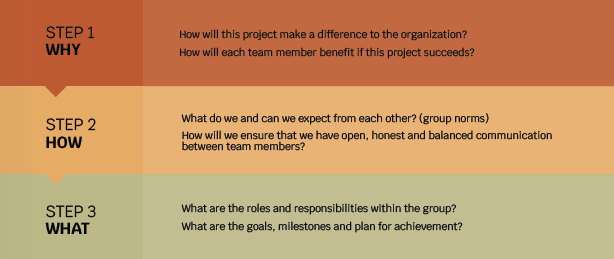The idea that assembling a team of your highest-calibre employees will result in a high performing team seems logical enough. Unfortunately, it’s 100% wrong!
In the quest of decoding the attributes of successful teams, researchers at Google, in an initiative called “Project Aristotle”, looked over the last 50 years of academic research and at the performance of the many teams working at Google. Surprisingly, they found there was no correlation between the composition of a team and the likelihood of success; that is, the members of the team, personality types, or skill sets do not affect the overall team performance. You can assemble a team of your star players, but this does not mean the team is any more likely to succeed than a team comprised of average players.
What they identified as the key driver of team performance was “group norms”, also commonly known as the behavioral standards, traditions, and unwritten rules governing how groups of people behave when they come together. Some teams’ group norms included celebrating team member birthdays and putting an emphasis on relationship-building informal conversations at the beginning of every meeting, whereas other groups discouraged small talk and would get right down to business. The interesting part was that the norms of some of the effective teams were strikingly different to the norms of other equally successful groups. So how do you identify which norms matter the most?
The secret is, that it’s not so much about what you think is important, it’s what matters most to the team. Ask your team members to spend ten minutes answering the following four questions before sharing their responses with the group: What was the worst team you were ever part of? What made it so? What was the best team you were ever part of? What made it so? Discuss as a group the factors that lead to a good team experience vs. a bad experience. The next step is to ask team members to suggest behaviors that will contribute to the current team’s success and write them all up on a screen or flip chart. Decide together which ones the group will support and adhere to, flagging any concerns and discussing how team members will respond to other team members not following the agreed norms. Write this all up into a document that is circulated to all and displayed in public, for greater accountability. A great example of this is “The First XV”, the team culture that has driven the All Blacks Rugby Union team to play at the highest level and dominate the sport year after year.
While much has been researched and written on human intelligence, an interesting study carried out in 2008 by Carnegie Melton, MIT, and Union College delved into measuring intelligence of groups, a collective IQ. The study focused on 699 participants that worked in small groups to complete a diverse series of tasks that required different types of cooperation. They found that teams that succeeded in one assignment tended to accomplish other tasks as well, whereas the teams that failed to successfully complete one assignment would also fail to complete the rest. The key factor of the successful teams that enabled collective IQ to emerge was how the teammates treated each other.

Further research identified two behaviors that the successful teams shared. The first was “equality in distribution of conversational turn-taking”, that is each member would speak or contribute in roughly the same proportion. Anita Woolley, the study’s lead author stated that:
As long as everyone got a chance to talk, the team did well. But, if only one person or a small group spoke all the time, the collective intelligence declined.
When you reflect on your team interactions, are they balanced or are there a couple of persons that tend to dominate the conversations? How can you reach a balance in the communications? One tool I have found to be quite effective is to ensure that every member of a group has to say something at the beginning of the meeting, whether it be what they expect from the meeting or sharing their biggest achievements and challenges faced in the previous week or acknowledging another member of the team for a behavior that they observed. By getting everyone to participate at the beginning of a meeting, they become much more likely to participate and speak up during the meeting.
The second behavior identified was related to the social sensitivity of the group members, that is, how skilled they were at understanding how others felt based on nonverbal cues such as tone of voice and facial expressions. They would know if someone was feeling upset or left out and take action to remedy this. This is also often referred to these days as emotional intelligence (EI). What the social sensitivity creates is interpersonal trust and respect and a sense of “psychological safety” where team members can be themselves and speak up or take a risk without undue fear that they will be embarrassed, rejected, or penalized for it. Emotional intelligence is a skill that can be developed and has been proven time and time again to be the most important skill for managers and leaders to have. A Harvard study found EI to be twice as important to managerial success as the factors of having a high IQ or high level of technical skill combined.
For “Project Aristotle”, psychological safety was identified as the most critical norm vital to team success. When this was combined with clarity of goals, roles, and a culture of dependability, everything would fall into place. They published their research in 2015 under the title “The five keys to a successful Google team”. It’s an article well worth reading which identifies some key factors that every manager needs to consider if they want to build a team ready to tackle the biggest challenges. The five factors Google identified are:
- Psychological safety
- Dependability
- Structure and clarity of goals and roles
- Personal meaning of the work to each team member
- Impact of work (belief that the work the team is doing matters)
My observation is that many teams fail unnecessarily because they focus on “What” they need to do and rush to take quick action for quick results, skipping two critical steps, “Why” and “How.” If we take the metaphor of target shooting, the best results require the “Ready” and “Aim” steps to be completed before we pull the trigger and “Fire”. Pulling the trigger while the gun is still tucked into your waistband can have disastrous results.
STAR teams start with “Why” as the critical first step before turning their focus to “How” and lastly “What”. The “Why” is the most critical stage because it creates the context for all that follows. As Google identified, unless you believe that the work that you’re doing is going to make a difference and it’s linked to something that is personally important to you, you’re not going to demonstrate a high level of engagement (also known as discretionary effort). High-performance teams go above and beyond because they want to, not because they are told to do so.
The “How” is all about the culture of the team (or group norms), building trust and respectful relationships between the team members for open, honest, and balanced communication to take place as well as the positive expectation that group members can count on each other to complete high-quality work on time.
Three Steps to building a STAR Team

Unfortunately, this step is often overlooked in the rush to get started, resulting in poor outcomes due to lack of trust and miscommunication between team members.
The final step, the “What”, is creating the plan and structure for the group including clarity on the goals, roles, and responsibilities within the group, ensuring team members work to their strengths and to a shared plan agreed on by all. Doing a strengths inventory of team members is a very smart move, if you are lucky enough to have a Cristiano Ronaldo in your football team, you would be crazy to waste his talents in a defensive role. A good plan will identify milestones along the project pathway and allow some of the project steps to run in parallel when possible. The plan should also identify how information will be stored, shared and collaborated upon as well as how regular communication will occur to keep everyone in the loop. Accountability is the secret ingredient to high performance in teams. If people know they are not going to be held accountable, then they will be much less likely to deliver what is promised. When promises are broken, trust decreases, and teams become inefficient.
So, don’t let your team fall into the trap of focusing on the “What” first (or if you have, it’s never too late to take a few steps back to get your foundations secured). You have probably heard the saying, “Slow down to speed up!” Same goes for successful teams. Slow down, create the context by focusing on the “Why”, build the trust and teamwork through “How”, develop the “What” plan, and then, make it happen. It may appear to be more work, but it will increase the chances of the project succeeding immensely.
So, that’s it, team success in three easy steps. Right? Well, like any other new skill, it takes some work and time to master it and it’s easier when you get some assistance to make it happen. If you’d like to request a high-performance team blueprint to use for your team, drop us a line and we’ll send it over to you.









